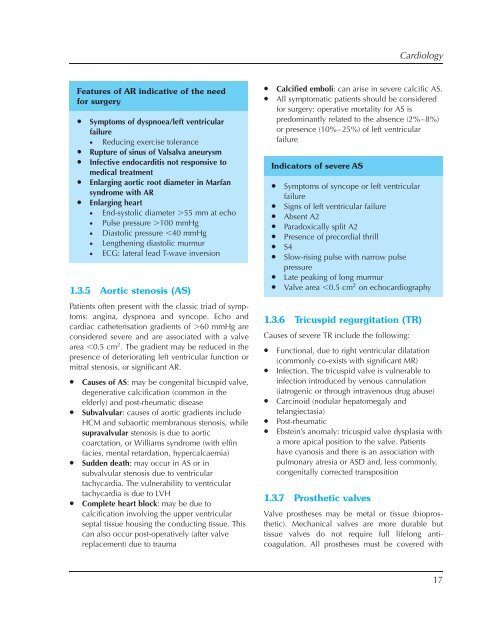Essential Revision Notes for MRCP Third Edition - PasTest
Essential Revision Notes for MRCP Third Edition - PasTest
Essential Revision Notes for MRCP Third Edition - PasTest
- No tags were found...
You also want an ePaper? Increase the reach of your titles
YUMPU automatically turns print PDFs into web optimized ePapers that Google loves.
CardiologyFeatures of AR indicative of the need<strong>for</strong> surgery• Symptoms of dyspnoea/left ventricularfailure• Reducing exercise tolerance• Rupture of sinus of Valsalva aneurysm• Infective endocarditis not responsive tomedical treatment• Enlarging aortic root diameter in Marfansyndrome with AR• Enlarging heart• End-systolic diameter .55 mm at echo• Pulse pressure .100 mmHg• Diastolic pressure ,40 mmHg• Lengthening diastolic murmur• ECG: lateral lead T-wave inversion1.3.5 Aortic stenosis (AS)Patients often present with the classic triad of symptoms:angina, dyspnoea and syncope. Echo andcardiac catheterisation gradients of .60 mmHg areconsidered severe and are associated with a valvearea ,0.5 cm 2 . The gradient may be reduced in thepresence of deteriorating left ventricular function ormitral stenosis, or significant AR.• Causes of AS: may be congenital bicuspid valve,degenerative calcification (common in theelderly) and post-rheumatic disease• Subvalvular: causes of aortic gradients includeHCM and subaortic membranous stenosis, whilesupravalvular stenosis is due to aorticcoarctation, or Williams syndrome (with elfinfacies, mental retardation, hypercalcaemia)• Sudden death: may occur in AS or insubvalvular stenosis due to ventriculartachycardia. The vulnerability to ventriculartachycardia is due to LVH• Complete heart block: may be due tocalcification involving the upper ventricularseptal tissue housing the conducting tissue. Thiscan also occur post-operatively (after valvereplacement) due to trauma• Calcified emboli: can arise in severe calcific AS.• All symptomatic patients should be considered<strong>for</strong> surgery: operative mortality <strong>for</strong> AS ispredominantly related to the absence (2%–8%)or presence (10%–25%) of left ventricularfailureIndicators of severe AS• Symptoms of syncope or left ventricularfailure• Signs of left ventricular failure• Absent A2• Paradoxically split A2• Presence of precordial thrill• S4• Slow-rising pulse with narrow pulsepressure• Late peaking of long murmur• Valve area ,0.5 cm 2 on echocardiography1.3.6 Tricuspid regurgitation (TR)Causes of severe TR include the following:• Functional, due to right ventricular dilatation(commonly co-exists with significant MR)• Infection. The tricuspid valve is vulnerable toinfection introduced by venous cannulation(iatrogenic or through intravenous drug abuse)• Carcinoid (nodular hepatomegaly andtelangiectasia)• Post-rheumatic• Ebstein’s anomaly: tricuspid valve dysplasia witha more apical position to the valve. Patientshave cyanosis and there is an association withpulmonary atresia or ASD and, less commonly,congenitally corrected transposition1.3.7 Prosthetic valvesValve prostheses may be metal or tissue (bioprosthetic).Mechanical valves are more durable buttissue valves do not require full lifelong anticoagulation.All prostheses must be covered with17
















